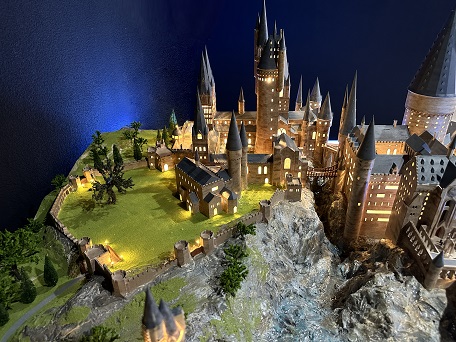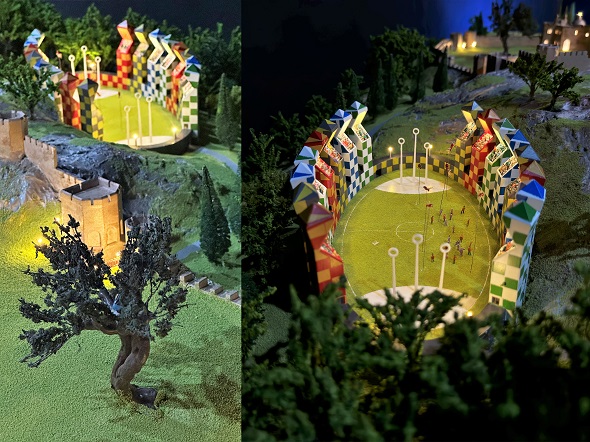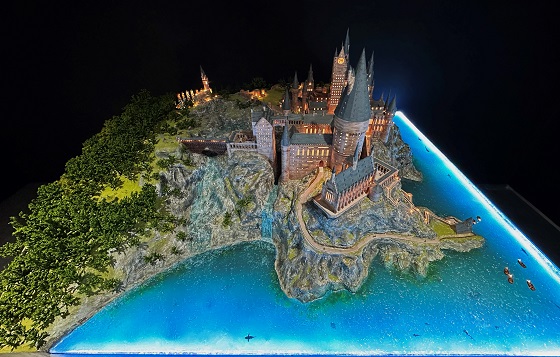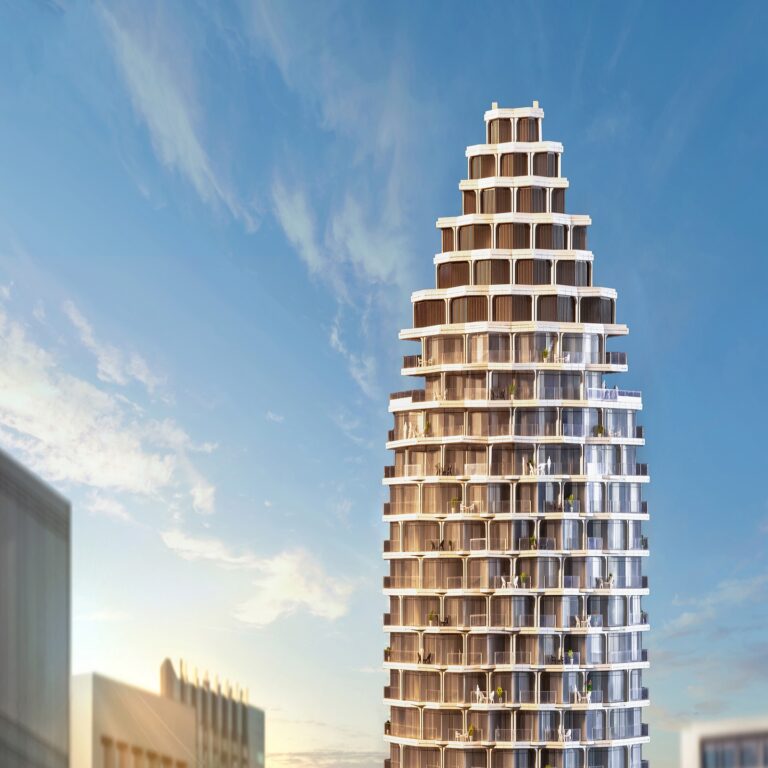QZY Models excels not only in designing and producing real estate and industrial models but also in historical architectural scene models. These models have a specific historical theme, feature buildings, and environmental designs to create a unique atmosphere. They are used for display, education, collection, and entertainment, and are exhibited in historical museums, theme parks, and game exhibitions. They can also be collected as collectibles.
Project Introduction
QZY Models’ first featured project taken over in 2023 is the European medieval castle model, which is more challenging in design and production than conventional real estate development models. The 1:125 scale setting maximizes scene details, including numerous elements such as castle towers, drawbridges, gates, lofts, and natural landscapes. Factors such as proportion, structure, details, and color are considered to ensure the model’s beauty and accuracy.

Design Process
Despite only being provided with conceptual images, we used our experience and understanding to create the 3D features by reviewing video footage and related image information. We completed the digital modeling work in one week and received the client’s approval. Our core creative team was essential in guaranteeing the final model’s highest quality by persistently fine-tuning and perfecting every aspect.
Difficulties of model making
We used 3D printing to shape the main volume and then our art team hand-painted it to simulate realistic colors and textures, resulting in a more authentic and historically accurate look. Compared to the conventional spray-painting process, our manual coloring technique is more delicate and better suited for presenting the building’s rich texture and historical characteristics.
The landscape part of the model is highly challenging, presenting complex terrain and diverse details. After modeling, we used CNC carving technology for fine-processing the irregular rocky terrain. To enhance realism, we used real stone paint spraying and manual painting to create the water features.
The water scenery was presented with a fault-cutting effect to recreate the underwater scene with realistic depictions of aquatic life, plants, and geology. Above the water, elements such as boats, waterfalls, stone houses, grasslands, caves, lush forests, eroded rock walls, and appropriately placed human activity scenes all came together in a rich and vivid model.

Overcoming Challenges in Model Making
Custom architectural model-making is a special blend of art, precision, and innovation. During the making of historical architectural models, such as simulation castle models or medieval castle models, the challenge increases manifold. These models need not only to replicate structures but also to capture the essence of bygone times and be appealing, visually accurate, and faithful to history.
Among those, QZY Models is incomparable because it adopts advanced techniques and technologies to surmount such challenges. Our methods assure a realistic model design for every project using techniques that range from 3D printing to manual coloring and to CNC carving. The processes that make our customized display models exceptional are now discussed.

Advanced Techniques in Model Construction
3D Printing for Main Structures
In model-making, structural accuracy is paramount, especially for medieval castle models with intricate details like towers, gates, and drawbridges. 3D printed models form the backbone of this process, allowing us to create complex forms with unparalleled precision.
We employ state-of-the-art 3D printers to achieve the perfect rendition of every architectural feature, down to the minutest detail. For the technology to be maximally advantageous, models on a 1:125 scale are commonly used, where even minor imperfections can disrupt the overall aesthetic. An example is seen in the faithfulness of castle battlements and turret designs reproduced millimeter-accurate for further refinement.
CNC Carving for Rocky Terrain
The terrain surrounding a simulation castle model is as critical as the castle itself. To capture the rugged charm of medieval landscapes, we employ CNC carving technology. This method allows us to recreate rocky terrains, uneven ground, and natural features with stunning realism.
CNC machines allow us to process irregular shapes and textures that can closely simulate geological formations in the real world. The carved terrains provide the base for integrating natural features such as grass, forests, and water features. This results in a living, breathing model landscape that complements the architectural centerpiece of the model.
Hand-painting and Texture Simulation
Realistic Hand-Painting Techniques
While technology provides the framework, it is indeed the human touch that breathes life into our custom models in architecture. Our skilled artisans use hand-painting techniques to simulate realistic colors and textures. Using this approach ensures that everything, from stone walls to wooden gates, exudes historical authenticity.
Hand-painting allows us to layer colors and textures in a way that spray-painting simply cannot achieve. For example, the weathered look of castle stones would involve painstakingly layering grays, browns, and greens to achieve an appearance of hundreds of years of exposure to the elements.
Rich Textures for Historical Authenticity
The textures on historical architectural models will be crucial for evoking such a sense of antiquity. Using fine brushes, sponges, and texturing tools, we create surfaces like eroded rocks, moss-covered walls, and worn wood. These rich textures are essential to realistic model design that takes the final product into the realm of museum quality.
Attention to Detail in Landscaping
A simulation castle model without its environment is dull. Landscaping enhances the narrative, providing context and depth to the structure. Here at QZY Models, we excel in creating immersive landscapes that go great with architectural design.
Recreating Complex Terrains
Thematic architectural model landscapes often feature complex combinations of rocky terrain, lush greenery, and open fields. This complexity is achieved by combining the CNC-carved terrain bases with additional, hand-sculpted elements. These terrains are then painted and textured to resemble their natural counterpart materials of soil, rock, and vegetation.
Natural Element Incorporation: Stone, Forests, Grasslands
The incorporation of as much real materials as possible enhances the realism. Natural stones are used to build miniature rock formations, while artificial grass and moss simulate lush greenery. The forests are made with specially hand-assembled trees, placed in strategic positions to provide just the right balance in the overall composition.
The interaction of these elements brings about a dynamic landscape that tells a story-be it a castle overlooking a thick forest or a serpentine path across a grassland.
Water Features with Dynamic Effects
Fault-cut to Show Details Underwater
One of the unique features in our custom display models is the fault-cutting technique, showing details of features underwater. The technique shows aquatic life, submerged rocks, and other features underwater clearly. We attain depth and movement for water features by layering translucent materials.
Boats, Waterfalls, and Scenes of Human Activity
Above the waterline, we add dynamic elements like boats, cascading waterfalls, and scenes of human activity. A medieval castle model might include villagers fishing, merchants ferrying goods by boat, and knights crossing a drawbridge. These aspects allow for a fuller storytelling and present an interesting model to the viewer.
Application of Historical Architectural Models
Historical architectural models are helpful in a variety of industries due to their versatility. These models have proven extremely valuable for use in education, entertainment, and even collection because they are powerful tools in storytelling and preservation.
Versatile Use Cases
Display in Museums and Exhibitions
One of the main uses of our bespoke architectural models is in museums and exhibitions. A museum display model can bring history to life by enabling the viewer to imagine how an ancient structure once sat within its environment. Our realistic model designs often feature in historical exhibitions where accuracy and detail are paramount.
Collection as High-Value Architectural Replicas
To enthusiasts and collectors, customized display models are a source of pride and treasure. These models feature not only an eye-catching look but also a finely detailed design that adds value to a collectible. For example, a medieval castle model in 1:125 scale features a level of craftsmanship desirable for serious collectors.
Value in Education and Entertainment
Educating the Audience about Historical Architectures
In educational settings, historical architectural models provide an interactive way to learn about history and architecture. By showcasing the construction techniques and lifestyles of the past, these models help audiences connect with history on a deeper level.
Enriching Theme Parks and Gaming Experiences
Thematic architectural models find their applicability in theme parks and gaming environments within the entertainment industry. For example, a modeled castle simulation might serve as the centerpiece in a medieval-themed park or inspire game design. These models enhance storytelling and create immersive experiences for audiences.
















